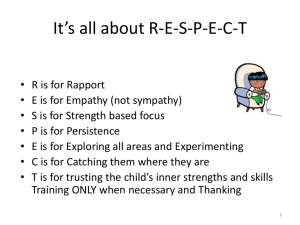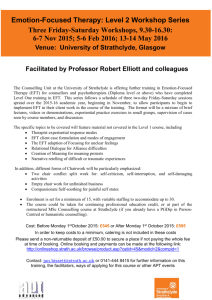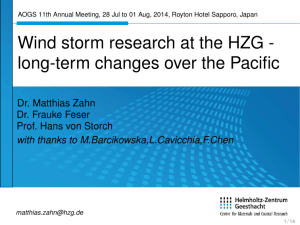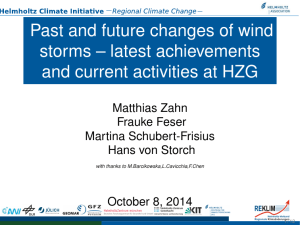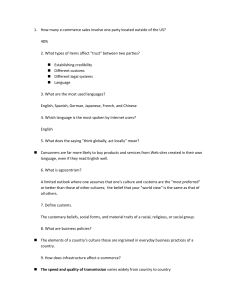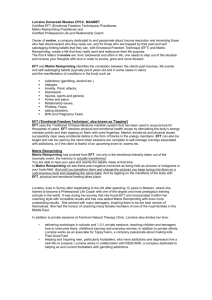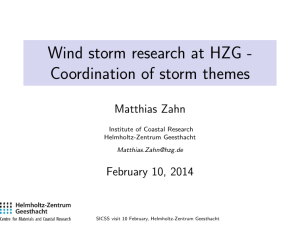Wind storm research at HZG - long-term changes from numerical models Matthias Zahn
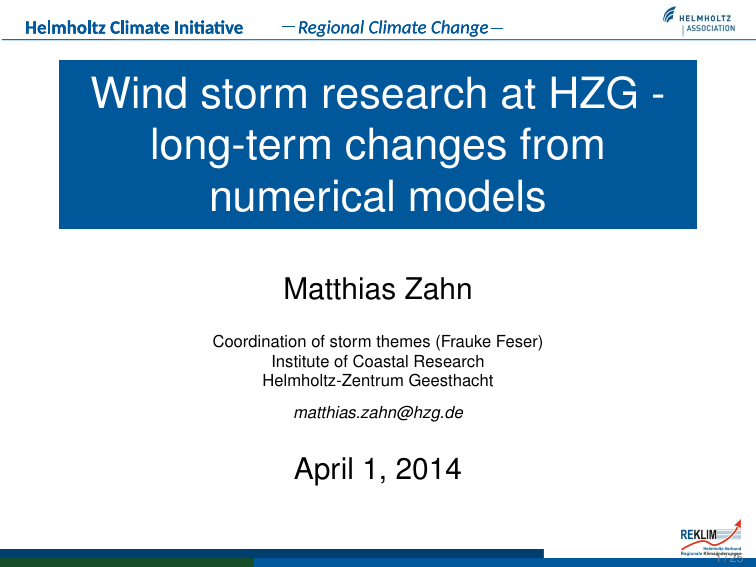
Wind storm research at HZG long-term changes from numerical models
Matthias Zahn
Coordination of storm themes (Frauke Feser)
Institute of Coastal Research
Helmholtz-Zentrum Geesthacht matthias.zahn@hzg.de
April 1, 2014
1 / 25
Focus: wind storm climate worldwide
Specifically
◮
◮
◮
◮
◮ most extreme fraction of storms: polar lows, medicanes, extra tropical storms, typhoons, hurricanes, etc.
climatologies, trends, statistics link to driving conditions impacts past decades and future climate scenarios
2 / 25
Tools of research: numerical models low-res global-domain
Simulation
◮
◮
◮ different types of atmosphere/ocean models dynamical downscaling re-analysis data to RCM domain spectral nudging
❄ high-res RCM-domain
Detection
◮
◮ automated storm detection methods applied methods based on scale separation
3 / 25
Why models?
◮
◮
◮
◮ homogeneity spatially extended information sufficiently long in time future scenarios are possible
4 / 25
Example for recent research: polar lows
◮
◮
◮
◮
◮
◮ diameter
<
1000 km strong winds
>
13
.
9 m s heavy precipitation poleward Polar Fronts in winter spiral cloud and cloud free core (Arctic Hurricane) rapid development c Dundee Satellite Receiving Station
5 / 25
Reproducibility of one polar low
15 Oct 1993, 6:00, The Swan
6 / 25
Detection, band-pass filtered MSLP
200-600km retained, PLs as distinct minima
7 / 25
Annual numbers of PLs (1949-2005)
Number of PLs per Polar Low Season (PLS), one PLS from July until June next year
8 / 25
Future projection of PL frequency
Zahn and von Storch, Nature (2010)
Under GHG warmed atmosphere (IPCC):
◮
◮
◮ number of annual PLs almost halves proxy for favourable development conditions decreases large inter model bias, but same direction of change
Left: number polar lows per PLS and scenario.
Right: Area and time-averaged ice free
SST − T
500 hPa over northern North Atlantic.
9 / 25
Spatial genesis distribution and its end of C21 change
1.0
0.8
0.6
0.4
0.2
0.0
−0.2
−0.4
−0.6
−0.8
−1.0
C20-B1
20˚ 20˚ 20˚ 20˚
1.0
0.8
0.6
0.4
0.2
0.0
−0.2
−0.4
−0.6
−0.8
−1.0
1.0
0.8
0.6
0.4
0.2
0.0
−0.2
−0.4
−0.6
−0.8
−1.0
C20-A1B
20˚ 20˚ 20˚ 20˚
C20-A2
20˚ 20˚ 20˚ 20˚
10 / 25
Further example: medicanes
50
°
10
°
N
W 5
°
W 0
°
5
°
E
NCEP
10
°
E 15
°
E 20
°
E 25
°
E 30
°
E 35
°
E 40
°
E
6
5
45
°
N
4
40
°
N
3
35
°
N
2
30
°
N
1
25
°
N
0
1950 locations of genesis
1960 1970 1980 1990 number per season
Cavicchia (2013), NCEP downscaled to 10km resolution with CLM
2000 2010
40 E
11 / 25
Further example: typhoons typhoons in A1B scenario, different detection configurations, same trend
12 / 25
CONTINUATIVE APPROACH: global downscaling low-res global-domain
❄
◮
◮
◮ apply a global ECHAM6 dynamical downscaling to global domain (M. Schubert-Frisius) spectral nudging
◮
◮
◮ which nudging configuration?
how well are storms simulated?
determination currently underway high-res global-domain
13 / 25
TOKAGE under different nudging configurations
110˚
60˚
BEST Track Storm
NCEP values
EH6_n1_T05_av_05dv
EH6_n1_T05_av_09dv
EH6_n1_T11_av_001dv
EH6_n1_T11_av_01dv
EH6_n1_T11_av_05dv
EH6_n1_T11_av_09dv
EH6_n1_av_001dv
EH6_n1_av_005dv
EH6_n1_av_01dv
EH6_n1_av_05dv
EH6_n1_av_09dv
EH6_n1_dvw_005dv
EH6_n1_dvw_echam6_dv
EH6_n1_ev_005dv
50 0
12 13 14 15 16 17 18 19 20 21 22
14 / 25
Summary
At HZG, different types of storms:
◮
◮
◮ are simulated using dynamical downscaling are detected with spatial filters will be simulated using global downscaling
Some of our results (shown here):
◮
◮ no past change of polar low/medicane activity significant decrease in a warmed future
15 / 25
Thank you very much for your attention
http://coast.hzg.de/staff/zahn/
16 / 25
